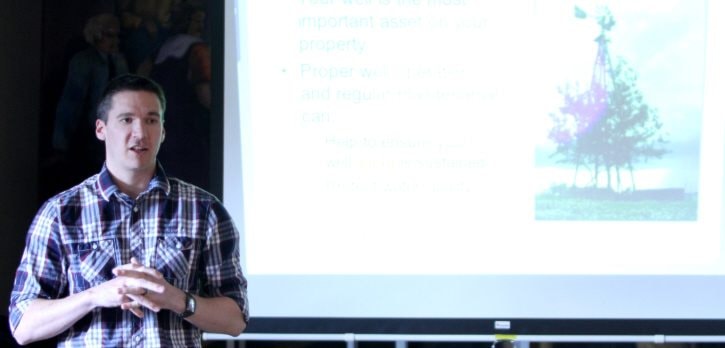Central Alberta farmers are getting an education from Alberta Environment on the importance of decommissioning water wells, which are no longer in use.
A workshop was held at the Schultz Hall on Highway 53 on Thursday, March 12 for farmers interested on learning more about the process, environmental factors and possible health concerns.
“You are responsible for the wells on your property,” Alberta agricultural water engineer Brandon Leask told the audience.
When it comes to wells, Leask says the number one enemy organizations and the landowners themselves face is old abandoned wells.
When an active well is no longer producing adequately, it is abandoned. However, if it is not properly plugged, it can affect a new well drilled in the same area.
“Abandoning a water well is just what it sounds like; walking away and doing nothing about it,” said Leask.
He says in the past, it has been people’s mindset to simply abandon old wells. However, he wants to change that perception and keep landowners proactive when it comes to handling old wells.
Wells can be plugged with special expanding clay called bentonite then capped with clean clay.
While casing does not always have to be removed —in the case of some very old well sometimes it is not possible — the liner should be pulled before filling the well. If it is not, there is a potential for inter-aquifer mixing.
Bridging can also occur if the bentonite is not sifted before entering the well. The fine dust will settle on the water and expand before the chips can fill the well; leaving everything below the waterline untouched.
“What we recommend it is it done by a professional water well contractor,” said Leask.
“Probably the reason most of you are here is you are interested in doing it yourself,” he added.
In order to properly do this, landowners must first obtain the records of the well, sketch the well, measure how much bentonite is needed, disinfect the well and remove the liner.
After a well is plugged, surface reclamation must take place; it is required the casing be cut off below the grade.
The cost of decommissioning a well varies depending on the method used, casing size, well depth and difficulty removing the casing. “It’s not so simple as just pouring chips down,” said Leask.
One of the questions Leask received was, what happens if there is a pre-existing abandoned well on newly purchased property. “It’s the current owners (responsibility),” said Leask.
For landowners with wells that were on the land before them, Leask’s advice is to call in a trusted well driller to investigate its depth and how much bentonite is needed to plug it.
Since 1972, landowners have had to submit reports and nowadays many wells have GPS references to help locate them.
As an incentive for people to decommission their old wells, farmers are now encouraged to submit a water management plan for eligibility in the Growing Forward 2 program.
Standard incentive projects pay one-third of the cost, up to $5,000; special incentives pay 50 per cent to different maximums. When it comes to decommissioning water wells, farmers can get up to $2,000 per well, up to three wells.
However, to maintain eligibility, the work must be done by a licensed water well contractor, a long-term water management plan must be approved prior to construction and the person must be an active farmer, rancher or producer.
“We have a higher payout because there’s a lot of liability,” said Leask; it is the aquifers at stake, he added.
He also encourages landowners to talk to their counties about water well decommissioning rebate programs because not everyone is covered under Growing Forward 2. “Our grant program helps farmers. There’s a whole acreage community out there our program doesn’t help,” he concluded.
